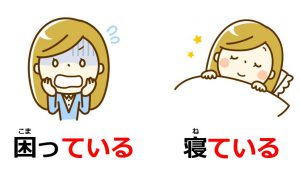Last time, you learned present progressive tense: “ごはんを食べている (I’m eating a meal),” and resultant states: “かばんを持っている (I have a bag).” As you notice, the concept of Japanese tense and aspect are different from English. In this lesson, we would like to focus on how to express existence and possession.
How ある and いる Work When Expressing Existence and Possession
| Table of Contents How to Express Existence How to Express Possession |
Basic Idea of ある and いる
| Plain | Negative | |
|---|---|---|
| To be (inanimate things) | ある / あります | ない / ありません |
| To be (animate things) | いる / います | いない / いません |
The basic usage is that ある can only be used for inanimate things, while いる can only be used for animate things. Both ある and いる indicate constant states which last constantly and the state won’t normaly change. Therefore, they don’t have the te-form. Be careful; as we mentioned in the previous lesson, the negative form of ある is an exception.
How to Express Existence
| 猫が | いる / います |
| Subject (animate) | Verb |
| There is a cat. | |
| 図書館が | ある / あります |
| Subject (inanimate) | Verb |
| There is a library. | |
That’s very simple. The only thing you have to keep in mind is if the subject is an animate thing or an inanimate thing. The definition sometimes confuses learners. Animals and insects are categorized into animate things without doubt. However, something like robots and germs depend on person’s opinion.
| うさぎが(いる / います)。 There is a rabbit. |
| おばけは(いない / いません)。 Ghosts don’t exist. |
| 病院が(ある / あります)。 There is a hospital. |
| ロボットが(いない / いません)。 There is not a robot. |
The Particle に: Location of Existence
| 公園に | 子供が | いる / います |
| Location of Existence | Subject (animate) | Verb |
| There is a child in the park. | ||
Here is a new function of the particle に, which indicates locations of existence. When it comes to expressing existence, the に part is usually (but not always) placed at the beginning. Here are some examples.
| あそこに虫が(いる / います)。 Insects are over there. |
| 駐車場に車が(ある / あります)。 There are cars in the parking area. |
| 先生は今家に(いる / います)よ。 The teacher is in [his/her] house now. |
| 日本語の本は図書館に(ある / あります)よ。 As for Japanese books, [they] are in the library. |
The particle に can be used with other verbs if they indicate existence. Don’t be confused with the particle で, which indicates locations of actions. It’s the key whether or not you take a specific action.
| 日本に(住む / 住みます)。 [I will] live in Japan. |
| 友達の家に泊まって(いる / います)。 [I’m] staying at my friend’s house. |
| 日本で(働く / 働きます)。 [I will] work in Japan. |
| 友達の家で勉強して(いる / います)。 [I’m] studying in my friend’s house. |
[adsense]
How to Express Possession
| Animated Thing | Abstract Attribute | Numerical Attribute | Part of Body | Other | |
|---|---|---|---|---|---|
| には…がいる | Suitable | ||||
| には…がある | Suitable | Acceptable | |||
| は…がある | Acceptable | Suitable | |||
| は…をしている | Suitable | ||||
| は…を持っている | Acceptable | Acceptable | Suitable |
Proper expressions will vary depending on objects. In English you can just use “have,” e.g. you have a sister, a dream, a fever of 38°C (100°F), good eyes, a car, etc. However, you have to use different expressions in Japanese. Let’s check each usage one by one.
Animated Thing: には…がいる
| [僕には] | 素敵な彼女が | いる / います |
| [Topic] | Subject | Verb: Possession |
| [As for me], [I] have a wonderful girlfriend. | ||
When you express that you have animate things, you use には…がいる. You may wonder about the function of the particle に, however, we think you should just memorize this as a set phrase without logic.
| 佐藤さんには子供が3人(いる / います)。 Sato-san has three children. |
| 僕には可愛いペットが(いる / います)。 I have a cute pet. |
The particle に is sometimes omitted especially when the particle は indicates contrast in context.
| 佐藤さんには子供が3人(いる / います)。 |
| 僕には可愛いペットが(いる / います)。 |
Abstract Attribute: には…がある
| 私には | 夢が | ある / あります |
| Topic | Subject | Verb: Possession |
| As for me, [I] have a dream. | ||
When you express that you have an abstract attribute such as a dream or talent, you use には…がある. Like the above, you should just memorize this phrase. In this context, “持っている: to have” is also acceptable, but not recommended.
| 井上さんには歌の才能が(ある / あります)。 Inoue-san has a talent to sing. |
| 携帯電話には録音をする機能が(ある / あります)。 Cell phones have a function to record. |
Numerical Attribute: は…がある
| [私は] | 38度の熱が | ある / あります |
| Topic | Subject | Verb: Possession |
| As for me, [I] have a fever of 38°C. | ||
When you express that you have numerical attributes, you use は…がある. Be careful because the particle に disappears here. When it comes to fevers, people are often concerned about whether you have a fever or a normal temperature. Thus, numerals can be omitted (only in this case).
| 近藤さんは身長が170cm(ある / あります)。 As for Kondo-san, he is 170cm (5.57ft) tall. |
| 北野さんは体重が60kg(ある / あります)。 As for Kitano-san, his weight is 60kg (132lb). |
| [私は] 熱が(ある / あります)。 [I] have a fever. |
Part of Body: は…をしている
| ビートルズは | いい声を | して(いる / います) |
| Topic / Subject | Direct Object | Verb: Possession |
| The Beatles have a nice voice. | ||
When you express that you have a remarkable part of your body, you use は…をしている. You cannot use this sentence pattern without adjectives or adverbs. If you say “The Beatles have a voice,” that sounds strange in Japanese because everyone has a voice. している is the te-form + いる of する, but you should just memorize this as a set phrase without logic, either.
| 田中さんはきれいな目をして(いる / います)。 Tanaka-san has beautiful eyes. |
| 野村さんはかっこいい髪型をして(いる / います)。 Nomura-san has a cool hairstyle. |
Other: は…を持っている
| [私は] | ノートパソコンを | 持って(いる / います) |
| [Topic / Subject] | Direct Object | Verb |
| [I] have a laptop. | ||
Apart from the cases above, you simply use “持っている: to have.” As you learned already, the te-form + いる indicates resultant states while the plain form: 持つ indicates a momentary action like “to hold.”
| 車を持って(いる / います)。 [I] have a car. |
| 日本語の辞書を持って(いる / います)。 [I] have a Japanese dictionary. |
Summary
- ある can be used for inanimate things while いる can be used for animate things.
- The particle に indicate locations of existence.
- Expressions for possession will vary depending on objects.
In this lessons, you have learned how to express existence and possession by using constant states (ある・いる) and resultant states (持っている). This is one of the cases where the concept is totally different from English. Thus, try to learn the patterns as it is. Next, you will learn how to express past tense with the ta-form.

Present Progressive Tense & Resultant States with Te-form

Past Tense and Present Perfect Tense with the Ta-form



